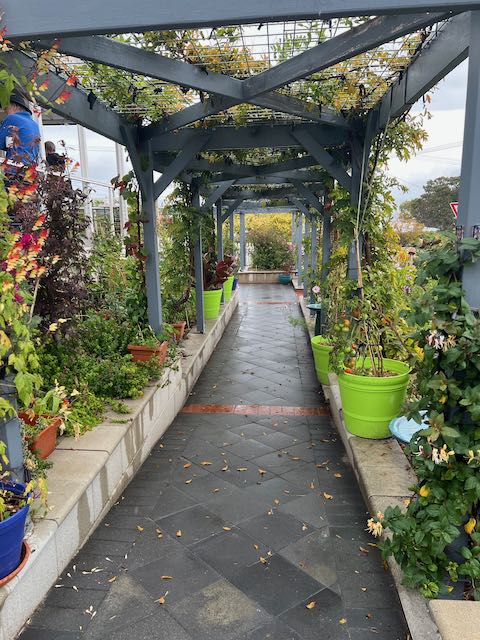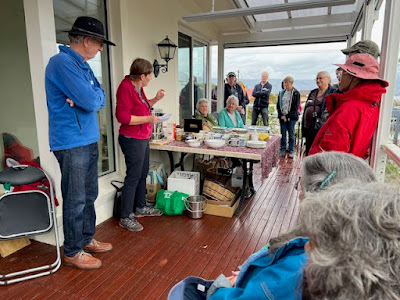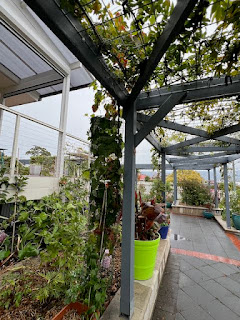Our last visit of the 23-24 FGG season was to an urban garden that showed us what a creative approach to form, structure, colour and variety can do to make a productive garden beautiful.
But let’s start at the beginning. When Vivien and Mark bought their Bellerive property twelve years ago their house and garden looked like the two photos below. The garden was ‘a clean slate’.
They threw themselves into renovating their house and transforming their garden. Four years ago, the pace of garden redevelopment increased when they bought a strip of the adjoining car park along their back fence and Vivien joined Mark in retirement.
After a lot of looking at other gardens, reading, learning and experimenting we have the amazing result of Vivien’s creative approach and Mark’s talent for turning her ideas into reality. Because, don’t be mistaken, most of the work in this garden was done by these two people themselves.
There is so much to see in this relatively small garden that it is hard to choose what to show you. Here are some examples of Vivien and Mark’s artistic flair:
Did you spot a number 8 in one of these photos? Have another look. Mark installed them on each bed after Vivien found and fell in love with them in a Turkish shop in town. Now it is easier for them to tell each other where work needs to be done.
Nearly all paths are very nicely paved and nearly all beds have a paved border that you can sit on while working. Paving patterns and colour combinations used, and the very professional way in which the paving was done by Mark, give the garden a great look. It also means that you don’t get dirty when walking through the garden in rainy conditions.
Around the perimeter on all four sides of the garden there are a total of 46 fruit trees, all dwarf varieties Viv tells me. They will need to be kept in check if they want to keep a manageable garden over years to come.
Vivien does all the pruning. She uses a handy little mini chainsaw for the thicker bits:
Despite the Clarence City Council having installed "No herbicide spray area “signage around the property, recently two workers sprayed widely along their fence line, and adjacent pavement, gutter, and road. Viv and Mark were very worried that herbicide spray drift might kill some of the garden but so far, they have seen little obvious herbicide damage.
That brought us onto the subject of weeding: what weeding methods there are, and how effective they might be. We discussed the topic and together came up with twelve weeding methods:
- Weed by hand using tools such as a hoe
- Smother: cardboard, paper, mulch, weed mat, old carpet)
- Solarise under black plastic
- Use steam: you can get special steam guns
- Use hot water: boil a kettle and pour it over your weeds
- Drown in a bucket, and later on compost
- Weed-burn with a gas flame
- Use salt
- Use vinegar
- Spray with nonanoic-acid herbicides such as Slasher and Seasol Earthcare that kill on contact.
- Use glyphosate herbicides such as Roundup and Zero ( which were declared in 2015 to be "probably carcinogenic to humans" by the World Health Organisations International Agency for Research on Cancer).
We were lucky that Vivien (on the left, in the red) and Mark (on the left, in blue) have a large covered deck because intermittent rain made this one of our more challenging visits:
Now let’s look at some of the food-plants in this garden:
Above is a young paw paw tree! Most of us would think that you can’t grow paw paw in Tasmania, but this Babaco variety is a cold-tolerant variety that can be grown in cool but frost-free micro climates in spots that don’t get too much wind or sun. Vivien and Mark bought it from Diggers. For more info see https://www.diggers.com.au/products/babaco-champagne-fruit .
The photo above shows a stunning Amaranth bush. Its leaves and seeds are edible. Amaranth has anti-inflammatory properties. Its seeds are an ancient gluten-free grain.
In the top-part of the photo above you can just see seed pods of Daikon. Daikon is a mild-flavoured radish. The seeds in their hull can also be eaten. Mark let me taste one, and these seed pods taste a bit like brassica, which is no surprise, because Daikon is part of the Brassica family.
Above you see a very ornamental perennial chilli, a Rocoto. The fruits are black at first and then turn red when ripe.
Above are two more photos of fruits that looked great in that day’s rainy conditions.
I was impressed by two really well-designed compost bays:
The lid has fine mesh. The compost is complete enclosed. No mice or rats are able to get in. The beams at the front can be lifted out. A great design!
Grapes are growing up the walk-through pergola and will in coming years begin to provide shade in summer, but not in winter when you want the light.
There is a berry-cage in a sheltered warm area between the fence and the house:
And a rain water tank that the rain slowly trickled into during our visit:






















No comments:
Post a Comment
Note: Only a member of this blog may post a comment.